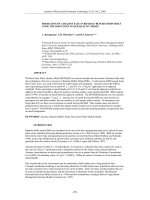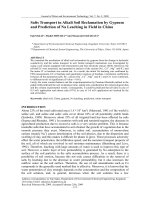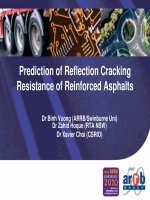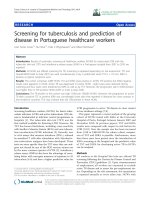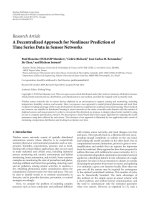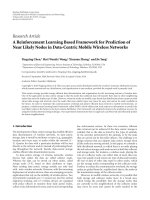Prediction of Reflection Cracking Resistance of Reinforced Asphalts - Dr Binh Vuong (ARRB/Swinburne Uni) pot
Bạn đang xem bản rút gọn của tài liệu. Xem và tải ngay bản đầy đủ của tài liệu tại đây (1009.04 KB, 31 trang )
Prediction of Reflection Cracking
Resistance of Reinforced Asphalts
Dr Binh Vuong (ARRB/Swinburne Uni)
Dr Zahid Hoque (RTA NSW)
Dr Xavier Choi (CSRIO)
www.arrb.com.au Building on 50 years of road research
1. Background
2. Constructability and field performance
3. New pavement design models for reinforced
asphalt
4. New material assessment methods for pavement
design
5. Evaluation of reinforced asphalt products for a
road application in NSW
Contents in this presentation…
www.arrb.com.au Building on 50 years of road research
1. Background
NEED MORE COST-EFFECTIVE SOLUTION FOR
• reflective cracking in asphalt overlays on existing cracked
concrete and flexible pavements that can significantly shorten
fatigue life of asphalt overlays
www.arrb.com.au Building on 50 years of road research
Use of asphalt reinforcing materials (ARM)
Theoretically, ARMs
• have very high tensile
stiffness and strength
• can be selected according
to their capacity to deal with
the dominating failure mode
• can offer a
more cost-
effective solution to retard
deflection cracking
than
using traditional materials
(asphalt, concrete,
unbound)
Asphalt overlay
Reinforced grid
Existing cracked
concrete or asphalt
layer
Granular subbase
Reflective cracking retardation
www.arrb.com.au Building on 50 years of road research
Commercial ARMs
• Examples of ARMs used in Europe and USA
Glass fibre grid
Bonded grid
Carbon fibre woven
Stitched or
warp knitted
Steel mesh
Polyester grid
www.arrb.com.au Building on 50 years of road research
2. Constructability and predictability of ARMs
MAJOR ISSUES NEED TO BE ADDRESSED
www.arrb.com.au Building on 50 years of road research
Overseas experience
• Trialled in Europe and USA (>30 years)
– Manufacturers’ claims: proper installation & good
performance
– Road authorities’ claims: construction problems/ material
defects & poor field performance
• Pavement design models
– Not sufficient field data (construction standards and field
performance) for empirical pavement design procedures
– Detailed analytical (finite element) procedures are
too
complex and do not consider construction issues
(not
accepted for routine practical use)
www.arrb.com.au Building on 50 years of road research
Australian experience
• Slow usage of ARMs to date due to issues of availability,
constructability and predictability
• Trialled in Australia (< 10 years)
– construction problems related to bonding between pavement
layers and bulging of reinforcement products
• Austroads mechanistic pavement design procedure
– does not consider reflection cracking in pavements in the overlay
thickness design
– does not enable quantification of the effects of reinforcing materials
Reinforcing materials used in Appin Road truck bay, Sydney (RTA)
www.arrb.com.au Building on 50 years of road research
2. New pavement design procedures
NEED
• similar framework as used in current Austroads
pavement design procedures
• taking into account
construction issues
www.arrb.com.au Building on 50 years of road research
Pavement modelling approach considered
• Reinforcing material (ARM)
and the surrounding asphalt
(used to hold the reinforcing
material) are combined into
a thin reinforced asphalt
layer (RAL)
• RAL is used as interlayer
in
asphalt overlays to retard
the rate of propagation of
reflective cracking
Asphalt overlay
Existing cracked
concrete or asphalt
layer
Granular subbase
Reinforced asphalt
product (asphalt
slurry +
reinforcing
material)
Extend cracks in
asphalt overlay
www.arrb.com.au Building on 50 years of road research
Material modelling approach considered
Multi-scaling approach
• micro behaviours of all RAL elements are modelled in
detailed FE analysis to determine RAL macro behaviour (
3D
orthotropic)
– assess impacts of RAL defects (bonding, bulging, defects) due
to construction
• RAL macro behaviour is used in pavement analysis to predict
maximum stresses/strains in pavement layers
– select appropriate material type (or layer thickness) for the
pavement layers concerned
www.arrb.com.au Building on 50 years of road research
Extended FE Austroads pavement procedures
• pavement system with RALs and
cracks modelled with FE
• design thermal and traffic loads
applied to the pavement system to
assess reflective cracking process
due to different failure modes
– Mode I - crack opening
– Mode II - shear transfer
• critical (maximum) stresses/strains
computed within each pavement
layer
• Austroads empirical performance
relationships used to predict design
fatigue life from the critical
stresses/strains
Mode I crack opening (thermal mode)
Mode II shear loading
www.arrb.com.au Building on 50 years of road research
3. Associated material assessment methods
NEED
• calculated RAL macro elastic properties
– theoretical elements (no defects)
– upper limits in pavement design
• measured RAL macro elastic properties
– real samples (with known defects)
– lower limits in pavement design
• assigned RAL macro elastic properties
– dependent on level of construction defects
– applied to a specified construction standards in pavement design
www.arrb.com.au Building on 50 years of road research
Theoretical methods for calculating RAL properties
• Detailed 3D FE analyses
– RAL element is explicitly
modelled as a
rectangular plate that
encloses at least four unit
cells of reinforcing
material
– The RAL element is then
subject to the following
prescribed boundary
displacements:
• uniaxial tension
• plane shear
– Calculate equivalent 3D
orthotropic material
properties using average
stress-strain relationships
Plane shear
uniaxial
tension
Reinforcing
material
In-plane tensile strain in xm direction
m
xmm
xm
xm
E
a
E
1
(3)
In-plane tensile strain in m direction
m
xmm
m
m
EE
a
(4)
m
xm
a
a
In-plane shear strains in xm-m direction
mxm
mxm
G
(5)
www.arrb.com.au Building on 50 years of road research
Calculated stresses and strains using 3D FE analysis
•Typical
reinforced
asphalt
products
• uniaxial tension
loading mode
• plane shearing
mode
Steel mesh
GlassGrid
Carbon Fibre
Steel mesh
Glassgrid
Carbon fibre
Steel mesh
GlassGrid
Carbon Fibre
www.arrb.com.au Building on 50 years of road research
Calculated RAL orthotropic elastic properties
G
AC
G
AC
G
AC
(Deformation
dependent)
AC
AC
AC
E
AC
799010400Carbon fibre
G
AC
G
AC
G
AC
(Deformation
dependent)
AC
AC
AC
E
AC
53125312Fibreglass
grid
G
AC
G
AC
G
AC
(Deformation
dependent)
AC
AC
AC
E
AC
79007000Steel mesh
T
m-
xm
G
xm-n
G
m-xm
n-m
xm-n
m-xm
E
n
E
xm
E
m
Shear modulus
(MPa)
Poisson’s RatioYoung’s modulus
(MPa)
Reinforcing
material
Subscript AC refers to asphalt. For example, E
AC
refers to Young’s modulus of asphalt
www.arrb.com.au Building on 50 years of road research
Laboratory methods for measuring RAL properties
• Applied to real reinforced asphalt samples (with defects
such as bulging, lack of bonding, tear and wear, etc)
• Proposed laboratory tests for in-plan tensile and shear
properties
– ASTM D3039 and ASTM D3518 (Test Methods for In-plan
Tensile and Shear Properties of Polymer Matrix Composite
Materials)
• Proposed laboratory tests for bonding and shear interlock
– pulling-out resistance
• Other tests (e.g. fatigue beam and plate loading tests)
www.arrb.com.au Building on 50 years of road research
Measured in-plan tensile and shear properties
• preliminary test results
– able to show
different
directional properties
– difficult to interpret due to
non-uniform tensile stress
and strain in the loaded
sample
• further improvements
required
– local stress and strain
measurement methods to
produce more consistent
results
– better interpretation methods
of the test results
0
5
10
15
20
25
30
35
0.000 0.005 0.010 0.015 0.020 0.025 0.030
Strain
Tensile force per metre (kN)
RA-GF-YY
RA-GF-45o
www.arrb.com.au Building on 50 years of road research
Measured bonding and shear interlock properties
• preliminary test results
– able to show different
deformation behaviours
when placed in different
surrounding environments
– difficult to interpret due to
non-uniform tensile stress
and strain in the loaded
sample
• further improvements
required
– local stress/strain
measurement methods to
produce more consistent
results
– better interpretation methods
0
5
10
15
20
25
30
35
40
0.000 0.005 0.010 0.015 0.020 0.025 0.030 0.035 0.040 0.045 0.050
Strain
Tensile force per metre (kN)
Wire mesh in asphalt
Wire mesh
www.arrb.com.au Building on 50 years of road research
4. Applications
EXAMPLE CASE
• Use the new pavement design procedures to
assess asphalt reinforcing materials (steel mesh,
fibreglass grid and carbon fibre woven) for a
road application in New South Wales
www.arrb.com.au Building on 50 years of road research
Asphalt overlay
220 mm cracked continuous
reinforced concrete
150 mm cracked lean mix
concrete subbase
10 m RAL
100 mm
AC
Subgrade CBR2
Maximum stress and strain
at initial crack
Maximum stress and
strain at extended crack
Pavement structure with RAL and cracks
www.arrb.com.au Building on 50 years of road research
FE analysis at initial crack condition
Shear strain results for Mode II
www.arrb.com.au Building on 50 years of road research
FE analysis at extended crack condition
Tensile strain results for Mode I
www.arrb.com.au Building on 50 years of road research
Mode I failure at initial cracking condition
• Comparison of tensile strains due to crack opening
Strains induced by thermal contraction of concrete base
-50
0
50
100
150
200
0 20 40 60 80 100 120
Depth from surface (mm)
Strain (micro strain)
Unreinforced
Wire mesh
Glass grid
Carbon fibre
Composite asphalt + carbon fibre
Top asphalt
Tip of existing crack
in concrete base
Bottom asphalt
All cases
(unreinforced and
RALs) produced
similar maximum
tension strains at
bottom of the
correction asphalt
layer
www.arrb.com.au Building on 50 years of road research
Mode II failure at initial cracking condition
• Comparison of shear strains due to shear loading
Strains induced by shear displacement at one side of crack
0
200
400
600
800
1000
1200
1400
1600
1800
2000
0 50 100 150 200 250 300 350 400
Depth from surface (mm)
Strain (micro strain)
Wire mesh - Initial crack
Carbon fibre - Initial crack
Glass grid - Initial crack
Composite asphalt + reinforced mesh layer
Initial crack tip
Crack in concrete base
Soft subgrade
All cases
(unreinforced and
RALs) produced
similar maximum
shear strains at
bottom of the
correction asphalt
layer

